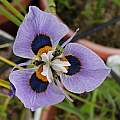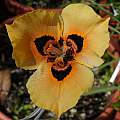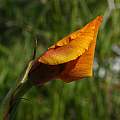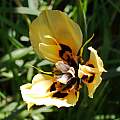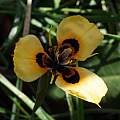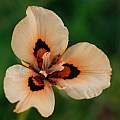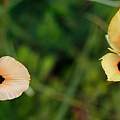The parents Seed parent: Moraea neopavonia X Pollen parent: Moraea villosa (form not specified)
The offspring
MM 03-99a (first two photos) is a very handsome flower with wide tepals. It's vivid orange, the color becoming even more intense next to the jet black eye. The backs of the tepals have some subtle shading that looks almost red when the flower is in bud. This cross is no more vigorous than a species Moraea. It's not very fertile as a seed parent (two successful crosses out of eight tries). As a pollen parent it does a bit better (7/18). The first photo shows the flower, while the second shows the plant in bud. When it was in bud for the first time, I thought the flower might be orange-red. Wishful thinking.
MM 03-99b (photos 3 and 4) is a little bit less attractive than its sibling. It's a slightly paler orange color, the tepals are not as full, and the black eye is not as large. However, occasionally it will put up a flower with weird flanges growing up out of the middle of the tepals. It's almost as if the flower is half-doubled. I have never seen this on any other Moraea, and it doesn't happen on every flower of this plant. I was able to cross this one with MM 03-05b, the plant that often makes four-tepaled flowers. If we could get a plant with both flanges and extra tepals, that would be...weird. This cross has normal vigor for a Moraea, and is quite fertile. As a seed parent it has two successes out of three tries, and as a pollen parent it is six out of nine. The first photo shows the flower with the flanges. The second photo shows what it looks like without the flanges (note that there's a little bit of a flange on the left-most tepal).
MM 03-99c (photos 5 and 6) is a subtly different color than its siblings, a kind of peachy-orange with less yellow in it. It's very hard to photograph accurately, but I tried to adjust the photos to get them close to what it looks like in the garden. I think these photos exaggerate the difference a little bit, but they are the best I could do. The sixth photo shows forms C and A side by side. Click on it to see the full photo.
This cross is another case in which crosses made with M. neopavonia tend to adopt its color scheme. In this example, we get an orange flower that has some of the shape of M. villosa. Unfortunately, I don't know which color form of M. villosa I used in the cross. My notes say only "weird form." That may have meant a flower that came up with twisted or malformed tepals (which happens occasionally). I've learned since then to take better notes.
Return to the Peacock Moraea Hybrids index
Galaxia - Gynandriris - Hexaglottis - Homeria A-J - Homeria K-Z - Moraea group A - Moraea group B - Moraea group C-E - Moraea group F - Moraea group G-I - Moraea group J-M - Moraea group N-R - Moraea group S - Moraea group T - Moraea group U-V - Moraea index

